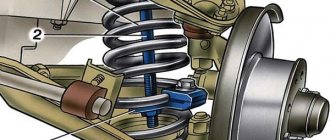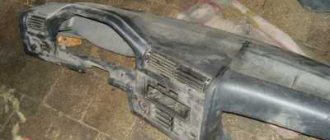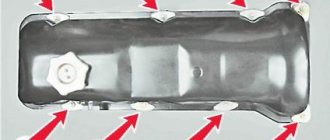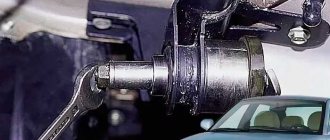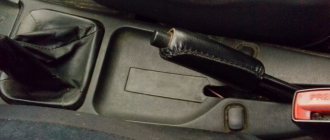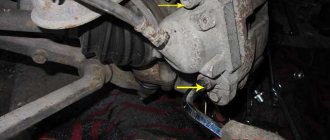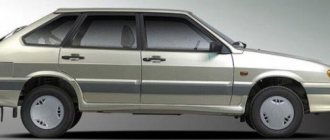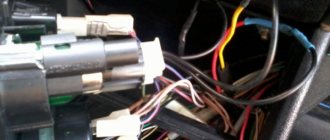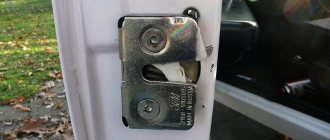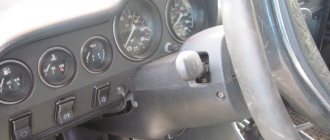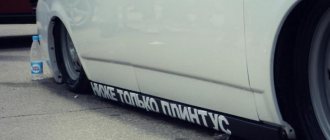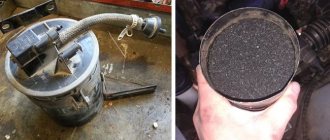Algorithm for replacing the front springs of a VAZ 2107
Prepare the simplest tool for the job; every car owner who at least sometimes repairs his iron horse should have it.
You will need:
- A set of keys (you should have it in your trunk);
- jack;
- a brush with metal bristles;
- wheel wrench;
- hammer;
- wire hook;
- mount;
- insulating tape.
The sequence for replacing the front springs is as follows:
1. Remove the shock absorber from the desired side and remove the wheel.
2. Next, you need to slightly unscrew the nuts securing the lower arm.
Place a lifting device under the lower arm and lighten the suspension (this is necessary to simplify the task of removing the stabilizer).
3. Unscrew the pair of nuts that hold the fixing bracket on the stabilizer pad.
4. Now remove the retaining bracket from its place, and then the cushion (stabilizer bushing).
5. Slightly loosen the ball nut that secures the steering knuckle and the lower hinge pin. Be careful. The nut must be unscrewed until it coincides with the end of the pin. Once this happens, lower the jack that is located under the lower control arm slightly.
6. Take a hammer and make several strong (and most importantly, sharp) blows to the outer part of the fist. Thanks to this action, you will achieve the release of the pin from the rotary cam.
7
Pay attention to the lower arm. At the moment when the pin is knocked out it will be on only one nut, you need to slightly raise the jack under the lower part of the lever
But there is no need to heavily load the suspension.
8. Unscrew the pin nut and lower the lower part of the lever as low as possible. Then, using a mounting tool, move the stabilizer (more precisely, its rod) over the stud. Now remove the jack and let the lever lower.
9. Take and make a hook out of wire and secure the upper lever with it. Please note that in this case there is no need to disconnect the steering knuckle. Try to mount the lever so that it is as high as possible - this will simplify access to the spring.
10. Pry the spring from below and pull it out from the bottom. There is a rubber spacer on the upper part of the support located on the body; remove it. If it is badly cracked, replace it. Now you have an idea of how to remove the front springs on a VAZ 2107.
Instructions for working with rear springs
Before proceeding with the replacement, you should place 2 shoes under the wheel located diagonally from the one being removed. Replacing the rear springs begins with unscrewing and removing the wheel, after which you need to place a block at the end of the rear axle beam and lower the jack. The entire mass of the car will fall on the block and compress the spring. The block should be positioned in such a way that it does not interfere with unscrewing the lower shock absorber mount. Follow the instructions further.
- Loosen the shock absorber mounting nut, unscrew it and remove the long bolt. The shock absorber must be unscrewed so that the spring can then be removed.
- Place 2 ties on opposite sides on the spring coils and securely fix them by pressing the pins with a wrench.
- Raise the car body with a jack until you can pull out the spring along with the ties.
- As a rule, the rubber spacer sticks to the metal of the body and remains in the glass, only the iron ring falls out. Therefore, you need to use a long flat screwdriver to pry up the rubber and remove it from the socket.
- Loosen the grips of the ties by unscrewing the studs one at a time with a wrench. Replace the ties on the new spring and tighten it to the approximate dimensions of the old one.
- Place a new rubber spacer with an iron washer on the upper coil of the spring. Its configuration is such that it must coincide with the shape of the upper turn.
1 — lower longitudinal rod; 2 — rubber bushing; 3 — bracket for fastening the lower longitudinal rod to the body; 4 — spacer sleeve; 5 — upper longitudinal rod; 6 - additional compression progress buffer; 7 - spring; 8 — upper spring cup; 9 — compression progress buffer; 10 — upper insulating gasket of the spring; 11 — shock absorber; 12 — lower insulating gasket of the spring; 13 - transverse rod.
- Place the part in the socket together with the ties and, supporting it with one hand, lower the jack with the other until the grips of the ties relax.
- Remove the ties, screw on the shock absorber and perform further assembly in reverse order.
Return to contents
Rear axle gearbox shank oil seal: how to replace video AvtoNovator
How to install a window regulator on a VAZ 2107 on your own
The rear axle gearbox shank oil seal is a seal located on the inside of the axle bearing. Like any oil seal, its main function is to create a seal, or rather, it prevents the leakage of transmission oil, which is located in the rear axle.
The main function of the gearbox oil seal
If depressurization occurs, then all the grease in the bearings is incredibly quickly washed out, and, as a result, they are destroyed. The main sign that the gearbox seal needs to be changed urgently is an oil leak. It is quite easy to detect this; a simple visual inspection is enough: if drops of oil are found on the surface of the gearbox housing, then you cannot hesitate. However, it should be taken into account that a thin oily film does not at all indicate the presence of a leak and is in no way a reason for carrying out repair work.
Please note that it is not always possible to limit yourself to just replacing the oil seal, since quite often it is also necessary to repair the gearbox, and this is best left to professionals. Despite the fact that replacing the rear axle gearbox seal is a rather responsible procedure that requires patience and attention, this does not mean that it cannot be done at home, you just need to strictly follow all the instructions.
Getting close to the rear axle gearbox shank oil seal
First of all, you should start by selecting the necessary tool; for this you will need a torque wrench, a two-jaw puller and, of course, a new oil seal and lubricant. Next you need to proceed in the following order. Place your “iron horse” on an overpass or inspection hole. You need to drain the oil that is located in the rear axle into a special container, now you can climb inside the car.
The first step is to disconnect the propeller shaft from the gear flange, turn on the parking brake and use a socket wrench to unscrew the nut securing the gearbox shank. In order to avoid turning the shank, it is not necessary to use a handbrake; you can also insert two bolts into the holes of the flange, and hold it with a mounting spatula or other suitable tool.
You will need a two-jaw puller to use it to press the shank flange off the gear. Sometimes this can be done without a tool, just with your bare hands, but, more often than not, you can’t do it without a puller.
Replacing the rear axle gearbox seal - the final stage
Everything is ready to dismantle the flange along with the dirt deflector and washer. Using a screwdriver or other suitable tool, pry up the old oil seal and remove it. The next step, of course, is to install a new seal. However, before you do this, it is worth checking the condition of the flange surface, as you can often find signs of wear and corrosion, which can be removed quite easily by grinding.
Now you need to apply grease to the working edge and seating surface of the new oil seal. Using a hammer and a special bushing, we press it into place. Only the blows should be soft and applied evenly over the entire surface in order to avoid unwanted distortions. All the removed parts of the shank are mounted in their original place, and it is advisable to replace the fastening nut with a new one.
Now the rear part of the car is hung out, and the axle shafts are disengaged from the gears. Use a dynamic wrench to tighten the shank nut, while its flange must be held by the bolts. Next, by rotating the flange by hand, we check the resistance; it should be uniform and light, no jamming or clicking is allowed. Finally, you need to check that there is no play.
When it's time to replace
VAZ 2107: replacing crosspieces on your own
There are several signs by which you can determine that it is time to replace the springs. These signs are:
- Detection of damage and defects in the product design. This malfunction can be determined by visual inspection, but first you need to put the VAZ 2107 car on an overpass.
- Their significant subsidence. If the vehicle's ground clearance decreases significantly, this indicates sagging of the devices in question. Springs quickly sag in such cases when the car is used to transport heavy loads every day. Also, those cars that are used as taxis also require frequent replacement of the devices in question.
If you find a problem with the springs on a VAZ 2107, then you should replace them without delay. This will extend the life of other suspension elements and save money. It is recommended to replace devices in pairs, since replacing only one element will cause the body to skew, which will negatively affect driving. In some cases, spacers help when the springs have sagged but are not deformed. Experts believe that you should not get carried away with spacers, since the physical properties of a car with spacers are many times worse. As a result of such modifications, the suspension does not function correctly, which affects many factors: from control to comfort. Therefore, if necessary, it is better to replace the springs, both rear and front. We will learn how this is done on a VAZ 2107 from this material.
Replacing the front springs of a VAZ 2107
Replacing the front suspension elements on the “seven” is carried out according to the following scheme:
- First, you need to install the car on an inspection hole or overpass, and then begin to remove the wheels, having first jacked them up.
- The front shock absorber needs to be removed.
- The nuts that secure the lower arm to the axle are loosened.
- Using a second jack, you need to place it under this lever, thus adding the suspension load. This is done to make it easier to disconnect the stabilizer.
- At this moment, you can use special spring ties (if available) to secure the springs in a compressed state. This will make further removal actions much easier.
The front springs of the VAZ 2107 need to be changed in pairs, just like the rear ones.
Helpful information
A short rod unscrewed from the stocking will facilitate dismantling and installation. For ease of assembly, a new rubber spacer and a metal lining are fixed to the spring with electrical tape or tape. Reinforced springs with VAZ 02 - 04 will increase the load capacity, but the car will become rougher to drive. It is easier to replace the torque rods with new ones without wasting time pressing the bushings in a vice. When experimenting with the height of the springs, you should remember the length of the shock absorber stroke. They may have to be lengthened or different ones used. During disassembly, the brake hose receives extra stress, which can lead to damage.
Follow safety precautions and replacing rear springs will not be a hassle.
AvtoVAZ began production of the VAZ 2101 in 1972. More than three decades have passed since then, but the concept of the “Classics” was discontinued only recently, less than a year ago. Over the course of 300 years, the car has acquired a huge number of supporters, and just as many enemies who hate the domestic auto industry. Let's not take either side. It’s better to talk about how we can improve this line, and more specifically, the VAZ 2107. I must say, this car lends itself well to tuning, although many believe that this task is a useless and thankless task. But in fact, tuning a VAZ is quite simple, relatively cheap and quite interesting. Thus, even minimal modifications make the car much better than it is. Not to say that “it can’t get any worse,” but the fact remains. So, external tuning, which is mainly used for domestic cars, is always capable of changing a VAZ for the better. But, as a rule, things rarely go further than that. But in order to make your car unique, you need to approach this activity with a creative component, so to speak, in a versatile way. After all, the aerodynamic body kit of the VAZ 2107, no matter how effective it is, is not capable of making it drive at a speed of 200 km/; this requires completely different modifications. We will not go into details of increasing power, we will turn towards improving maneuverability.
What you need to consider when installing rear disc brakes on a VAZ 2107
- Disc brakes are more efficient than drum brakes. Therefore, after installing disc brakes on the rear wheels, it is necessary to adjust the pressure regulator of the rear brake circuit, otherwise the rear brakes may operate earlier than the front ones, which may cause the rear axle to skid.
- To install disc brakes, you will have to carry out welding, milling and turning work, which will require special equipment. If it is not there, some of the work will have to be ordered externally.
- A car with a modified brake system (with disc brakes instead of drum brakes provided by the manufacturer) will not pass inspection.
- The requirements for the condition of the rear wheel hub bearings increase when installing disc brakes. The small amount of play allowed on drum brakes can cause damage.
- Tampering with the brake system is a dangerous step. If you are not confident in your capabilities, it is better to refuse to install disc brakes yourself or entrust the job to professionals.
Sequencing
How to change the oil in a manual transmission on a VAZ 2107 with your own hands?
To work, we will need the tools listed in the list above. In addition to them, we will need a rust cleaning liquid. It's better if it's WD40.
- The car is jacked up and the rear wheels are removed. Provides access to the brake drums and rear axle shafts. The axle shafts are thoroughly wiped off from dirt using a rag, and if necessary, treated with WD40. The best way to clean rear axle shafts is with WD40.
- The brake fluid from the system is drained into a previously prepared container. The pads are removed from the brake drum, then it is removed along with the axle shafts so that only the brake pipes remain. The first step is to remove the rear brake pads from the drum.
- The mounting rings and wheel bearings located under the rings are removed from the axle shafts. Green wheel bearings are visible under the retaining rings and need to be removed.
- Now the axle shafts are ground on a lathe so that their diameter matches the diameter of the selected brake disc (at this stage of the work, the car owner will need the help of a qualified turner). After this, holes are drilled in the axle shafts for the brake disc mounting bolts. Boring the rear axle shafts of a VAZ 2107 - work for a qualified turner
- The axle shafts improved in this way are installed back on the rear axle of the VAZ 2107. A brake disc is installed on top of them and screwed with a pair of mounting bolts as shown in the photographs above. After securing the discs, disc calipers with pads are installed on them, the rear wheels are installed in their regular places and the car is lowered from the jacks.
Video: setting rear disc brakes to “classic”
So, even a novice car enthusiast can change the front brake discs on a VAZ 2107. All that is required is the ability to use wrenches and a minimal understanding of how a disc brake system works. As for replacing rear drum brakes with disc brakes, it will not be possible to do this without the help of a qualified turner.
Sources
- https://bumper.guru/klassicheskie-modeli-vaz/tormoza/kak-snyat-tormoznoy-baraban-na-vaz-2107.html
- https://provaz07.ru/tormoza/snyatie-tormoznogo-barabana-vaz-2107.html
- https://semerkavaz.ru/tormoznaya-sistema/kak-pomenyat-tormoznojj-baraban-na-vaz-2107/
- https://avto-idea.ru/remont/zamena-zadnih-tormoznyh-kolodok-vaz-2107-svoimi-rukami/
- https://semerkavaz.ru/tormoznaya-sistema/zamena-kolodok-na-vaz-2107/
- https://semerkavaz.ru/tormoznaya-sistema/zamena-zadnikh-tormozov-na-diskovye-vaz-2107/
- https://bumper.guru/klassicheskie-modeli-vaz/tormoza/zadnie-diskovyie-tormoza-na-vaz-2107.html
How to replace rear springs on a VAZ 2101 - 2107
see also
Shock absorbers VAZ 2101 - 2106
- 28 0 22k
Which shock absorbers are better
- 168 4 162k
Which springs are better
- 74 4 82k
Shock absorber malfunction: symptoms and what affects
- 55 0 67k
How to check car suspension springs
- 32 1 39k
A sure sign of the need to replace the rear springs on a VAZ Classic (2107, 2106, 2105, 2104, 2101) is sagging of the rear part of the body. Moreover, ground clearance is significantly reduced even at minimal loads.
Let us visually analyze the entire process of installing standard springs with medium spacers. You can also experiment a little and install springs with high spacers, but this is allowed if you install simple springs from 2101, their article number 21010-2912712-01, and not reinforced springs from 2102, article number 2102-2912712. What are the best springs to install on VAZ cars is described here.
Springs from 2102 are much higher than standard ones; if they are used in combination with high or medium spacers, they will most likely lift the car very much. Consequently, the travel of standard VAZ shock absorbers is not enough, which means you will also have to change the shock absorbers to longer ones, for example Moskvich ones. Part number: 402-2915006-A. Additionally, it will be necessary to carry out welding work to weld additional rings onto the shock absorber itself. But replacing conventional springs with cargo springs is necessary in cases where you load your Zhiguli every day.
Removing the spring
On both sides of the car, spring removal is carried out in the same way. When replacing the front springs of a VAZ, you need to have a minimum set of tools on hand. A screed is a must—you can’t do without it. Further actions:
Place the ties opposite each other and compress the spring as evenly as possible. Using a 10mm wrench, unscrew the nuts that secure the stabilizer pad. Completely dismantle the cushion and stabilizer bracket. Loosen the lower ball joint to the control arm. Lower the second jack located under the lever. Once the lever is lowered, the spring can be removed.
There is no point in pressing the ball joint out of the steering knuckle - this is a very difficult task and requires a puller. It will be much easier to unscrew the three bolts that secure the cage to the lever. The spring should be compressed as much as possible. Be sure to remove the spacer from the top cup. If it is damaged or deformed, it should be replaced.
Installing a new spring
A new gasket should be secured to the new spring using electrical tape and set to its original position. To begin, take a mounting spatula and, holding the spring with it, thread the lower coil through the hole for the shock absorber. Secure it. A helical surface can be seen on the surface of the lower arm, demonstrating proper spring seating. After orienting the lower spring coil according to the screw surface, place a jack and lightly load the spring. Using a mounting spatula, finally seat it on the screw surface. Then place the stabilizer bar between the two stabilizer bar mounting studs. The remaining elements should be assembled in the reverse order of dismantling.
PURPOSE OF SUSPENSION VAZ 2107
The suspension of the VAZ Seven, like any other car, is necessary for safe and comfortable movement. Its design may seem complicated at first glance, but in reality it is not. The front and rear suspensions are a set of elements whose purpose is to provide an elastic connection between the wheels and the chassis of the car. The main function of the suspension is to reduce shock, vibration and jolts that occur when driving over uneven surfaces, which is inherent in roads with poor quality surfaces. It is worth looking at faults, repairs and modernization of the rear suspension in more detail.1
FRONT SUSPENSION
The VAZ 2107 has a double-wishbone independent suspension with an upper and lower wishbone at the front. The first of them is fixed through the mudguard strut, the second - to the front beam connected to the power elements of the body. The upper and lower arms are secured to each other by means of a steering knuckle and ball joints. To rotate the levers, the suspension design includes silent blocks made of rubber and a metal bushing. The softness and smoothness of the suspension is determined by elements such as springs and shock absorbers, and the stability of the car on the road is determined by the anti-roll bar.
The front suspension of the VAZ 2107 bears greater loads than the rear, so its design is made independent
REAR SUSPENSION
The rear of the car takes up less load than the front, so the suspension has a simpler design - dependent. The wheels of the rear axle of the “seven” have a rigid connection with each other. Such a system today, although outdated, still has positive aspects - high reliability and ease of maintenance.
REAR SUSPENSION STRUCTURE
Oddly enough, the design of the dependent rear suspension on the VAZ 2107 is simple, but has a number of its own features. Its main part is an element such as the rear axle, which connects the wheels to each other into one axle. Its beam is mounted to the car using so-called reaction bars. There are five of them in total: four longitudinal (they are located below) and one transverse (it is located behind the beam and does not allow it to move). The connection of these parts is made by special hinges - silent blocks.
- one of the springs;
- telescopic shock absorber;
- rod (transverse);
- the beam itself;
- longitudinal rod (upper);
- longitudinal rod (lower).
Two cylinder-shaped springs and buffers for their compression stroke are the main components of the rear suspension on the VAZ 2107. The lower part of the springs presses on the cups, which are attached to the beam, through dense rubber gaskets. The upper parts of the springs are located in the support cups of the body, and between them there is a device in the form of a gasket for insulation.
Two compression stroke buffers are made of rubber and are located in the springs themselves. An additional buffer is attached above the rear axle housing (to the very bottom of the body). It serves as a vehicle to absorb the load placed on the vehicle while driving through bad terrain at high speeds, or when other buffers fail.
In order to reduce vibration of the rear axle, the suspension device includes telescopic shock absorbers.
When to change springs
Two main signs that the VAZ 2107 springs need to be replaced::
- Damage appeared on the springs. This can be determined by visual inspection.
- The springs sagged a lot. This is noticeable in the reduction in ground clearance of the “Seven”, especially under load, and in the frequent breakdowns of the suspension when driving on a bad road.
In both cases it is necessary to make a replacement. Sometimes VAZ owners try to restore the stiffness of sagging springs using spacers. This decision is not entirely correct. The dynamic properties of a working spring and a spring with a spacer are different, which is why the suspension does not work quite correctly. In addition, cracks may soon appear on the reinforced sagging spring.
What to look for when choosing parts
There are several factors to consider when choosing springs.
This is interesting: Handbrake: self-adjustment of cables
Rigidity
Rigidity affects not only the comfort when driving in a car, but also when there is a load on other elements of its chassis system. It is more comfortable to ride on soft springs, especially on poorly paved roads. However, it is not advisable to install them on a car that often carries significant loads. Conversely, it is better to install stiff springs on cars designed to transport heavy objects. This is especially true for rear shock absorbers.
In the context of rigidity, another situation is relevant. Often, when purchasing new springs (especially for VAZ classics), a pair of identical springs included in one set may have different stiffnesses. Naturally, this leads to the car tilting to the right or left. It is almost impossible to check them when purchasing, so there are two ways to solve the problem.
The first is to install the spacers mentioned above. With their help, you can level the vehicle's ground clearance and achieve uniform suspension stiffness. The second way is to buy higher quality springs, usually from trusted manufacturers, usually foreign.
Stiffness is a physical quantity that in springs depends on the following parameters:
- Rod diameter. The larger it is, the greater the rigidity. However, here you need to take into account the shape of the spring and the diameter of the rod from which each coil is made. There are springs with variable overall diameters and rod diameters. More on them later.
- Outer diameter of the spring. All other things being equal, the larger the diameter, the lower the rigidity.
- Number of turns. The more there are, the lower the rigidity. This is due to the fact that the spring will bend along its vertical axis. However, additional parameters need to be taken into account here. In particular, a spring with a small number of turns will have a short stroke, which in many cases is unacceptable.
Length
The longer the springs are, the greater the vehicle's ground clearance will be. For each specific car model, the corresponding value is directly indicated in its technical documentation. In some cases, the length of the front and rear springs will be different. Ideally, the manufacturer's recommendations should be followed. Deviation from them is possible only for tuning or in the case of using the car for cargo transportation.
Turning parameters
The general name in this case refers to the diameter and number of turns. The overall spring stiffness depends on these two parameters. By the way, some spring models have an uneven shape with coils of different diameters. In particular, with narrow turns at the edges and wide ones in the middle.
However, such turns also have different diameters of the metal rod. Thus, the large-diameter coils located in the middle of the spring are made of a large-diameter rod. And the outer small turns are made from a rod of small diameter. Large rods work on large irregularities, and small ones, respectively, on small ones. However, due to the fact that small bars are made of thinner metal, they break more often.
Such springs are mostly original, that is, those that were installed from the factory. They are more comfortable to drive, but their service life is lower, especially when the car is constantly driven on bad roads. Non-original springs are usually made from a rod of the same diameter. This reduces the comfort of driving the car, but increases the overall life of the spring. In addition, such a spring will cost less, since it is technologically easier to manufacture. What to choose in this or that case is up to everyone to decide for themselves.
Spring selection
Domestic roads are not famous for their excellent quality, everyone knows this. Therefore, for many car enthusiasts, a serviceable and well-chosen suspension is the main task in ensuring comfortable movement. The main suspension unit is the shock absorber strut, and the spring is its important element.
They determine the ground clearance and provide the load capacity declared by the manufacturer. In addition, springs affect overall handling. One of the main criteria that determines the characteristics of an element is rigidity. Ideal will help avoid car roll when making sharp turns. If the unit is selected correctly, the roll in turns, regardless of speed, will not exceed a few degrees.
How to determine hardness
The main task of suspension springs is to quickly return the body to its original position, as well as ensure the vehicle’s load capacity and ground clearance. The stiffness of a spring means its ability to resist compression. Excessively hard, for example, will cause a lot of unpleasant sensations when driving on uneven roads. Too soft - they will absorb all the bumps, but in corners the car will begin to roll heavily.
The rigidity of these parts is influenced by several factors.
- Diameter of the rods (the thicker, the tougher).
- External diameter (the larger this indicator, the softer the element).
- Number of turns (the more turns, the stiffer).
- Shape (you can find barrel-shaped, conical, cylindrical, and each type has its own advantages and disadvantages).
You can find out the stiffness of the springs by the code or marks on them. However, if they are applied with paint, then you will not be able to navigate by them, because during operation the inscription will simply be erased. If there are no stamped marks, determine the hardness yourself using a hand press, scales and a regular school ruler.
On floor scales you need to put a board with a thickness of more than 12 mm. The width should be greater than the area of the end part of the spiral, and this side should be installed on the board. A board of similar size is installed on the upper end part, and the length is measured with a ruler or tape measure. Using a press, you need to compress the spring by 40–60 mm and look at the results on the scales.
This is not the only way to determine hardness. Remember your physics lessons. The product in this case is defined as an object of initial length that is stretched and compressed. Denoted by the letter "L". Based on Hooke's law of longitudinal deformation, body changes should be considered proportional to the initial length of the object “L” and the applied pressure force “F”. Next you need to use the formula x=F*L/C. In this formula, “C” is considered as a proportionality coefficient, depending on the number of turns, their radius and diameter.
Spring checking rules
Most car enthusiasts pay attention to its condition only after characteristic signs of malfunctions appear, for example, knocking, creaking, etc. But, as practice shows, it is easier to prevent a problem than to correct the consequences of a breakdown later.
“Tired” coils that need immediate replacement can be identified by characteristic signs.
- When hitting bumps, the suspension begins to “punch”.
- The smooth running of the car disappears.
- Vibration in the body.
- The car falls over on one side.
- When planting the front or rear helixes, the difference in height of the front compared to the rear is immediately noticeable.
- Ground clearance decreases.
- Upon careful inspection, it is noticeable that the coils touch each other during compression.
A spiral part may cease to perform its functions for several reasons. The main and obvious one is the natural wear and tear of the metal. The second reason: mechanical damage. The third and sometimes the most common is systematically exceeding the permissible load capacity of the vehicle, as well as driving over uneven surfaces and potholes at high speed. Also, the cause of breakdown can be natural corrosion due to high humidity and the action of chemical reagents on the road in winter.
If a crack or other damage is visually detected, the element must be replaced. It would be a good idea to check how much the spirals have sagged (do this using compression and weights). When performing diagnostics, you need to pay attention to the gaskets: when they are worn out, they also need to be replaced. If minor defects are identified, urgent work is not required.
But if the following defects are detected, parts should be replaced immediately:
- the lower or upper coil has broken off;
- traces of severe corrosion and mechanical damage are visible;
- ground clearance has noticeably decreased;
- uneven height of the corners of the car (the body falls on one side).
To diagnose spring malfunctions, you will need not only ordinary wrenches and other familiar tools, but also ties for removal. Without them, removing, for example, the front spiral elements is quite problematic. Although experienced motorists know ways to get by without them.
Springs and shock absorbers for the front and rear suspension of VAZ 2106, 2107, 2101, 2105
Well, spring has come, I decided to do the suspension. First of all, I spent a couple of days surfing the Internet. You need a sports suspension so that the car behaves steadily on the highway at least up to 160 km/h and has the least amount of roll when cornering. At the same time, I want a more or less comfortable ride in the city, over bumps, etc., I also go to the country. There is no need for a big understatement. The money factor is also important...
SHOCK ABSORBERS FOR CLASSICS VAZ 2106, 01, 05, 07, 03 – PLAZA SPORT, SINGLE-PIPE, GAS-OIL.
{loadposition user20}
In the picture above there is an ammo of the old and new batch (yellow and orange).
Monotube shock absorbers are better and more reliable than twin-tube shock absorbers. And of course gas-oil ones! First of all, I spent a couple of days surfing the Internet. The main fluctuations were between KYB and PLAZA. PLAZA won. In the Internet community there is a prejudiced attitude towards these shock absorbers, namely, that when buying them you are playing the lottery. Some drive perfectly for more than 100 thousand, some break down in the first thousand. Having reasoned logically, summarized the information and read the official explanations from PLAZA representatives, I came to the conclusion that the culprit is:
- Fakes. Questionable shock absorbers were purchased at markets, small shops, etc. Often the seller himself is confident in the originality of the shock absorber. To combat counterfeits, PLAZA changed the labeling and color of ammo. Now plaza sports are yellow (formerly orange), and plaza standard are orange (formerly yellow). I just got Plaza Sport front ones from different batches (one orange, one yellow). So take a look at the box before you buy it. And yet, in each box with a shock absorber there is a piece of paper with the serial number of the shock absorber with a stamp.
- Incorrect pumping. Many “tuners” don’t even know that shock absorbers need to be pumped before installation! Such shock absorbers have a high probability of failure in the first thousand. Bleeding shock absorbers before installing them on a car. I’ll briefly describe it: Turn the ammo head down, squeeze it all the way, 3-4 seconds. Hold, turn back, 3-4 seconds. hold, release (let open) and so on 6-7 times. To check whether it is pumped, we press sharply in the working position - if there are no dips, the stroke is uniform, then everything is fine. If there is, we pump it further. After bleeding, the shock absorber should remain in working position. Do not turn!
place only vertically
old shock absorber
The shock absorber on a VAZ classic is easy to install. Unscrew a couple of nuts on each - and you're done. This is in theory. In practice, everything is more complicated. The front shock absorber mounting bracket (new!) was broken during a previous repair at a car service (more precisely, a pin), and then carefully welded to the lower arm, instead of drilling and screwing. I deliberately left the first part of the description of the pendant, where I rejoiced at the good craftsmen. I forgot that I live in Russia and everything here is done through the ass. The main thing is that they didn’t tell me anything! There were also no new silent blocks. They simply weren’t installed, leaving the old ones!!! I'm just being crazy! It’s too late to figure it out, and it’s useless. I had to buy and install new silent blocks, steering rods and lower control arm.
rear
front, welding visible on left
SPRINGS FOR CLASSICS VAZ 2106, 01, 05, 07, 03 - SIRIUS, PROGRESSIVE or regular, you can FOBOS, but I was afraid to drive with FEAR springs, and they say they break often, maybe fakes?...
Sirius springs
I installed the front springs with variable pitch (progressive), the rear ones - regular ones. Replacing springs is much more difficult than replacing shock absorbers. The rear springs can be changed using a single jack.
You'll have to tinker with the front ones. You also need a shock absorber spring compressor. It's hard to find at 1am, so stock up in advance.
Now about the exhaust of all this tuning. The car is simply beyond words, elastic and moderately tough. Vibrations are at a normal level, there are no breakdowns in the suspension (I haven’t noticed it yet). Holds the track like a glove. By the way, the car turned out to be lowered (Sirius springs), let's see what happens next. In a coupe with a tuned engine, it handles no worse (or maybe better) than a budget foreign car! I want to ride and drive.
The cost of the upgrade is about 6,000 rubles. Definitely worth the money spent.
Replacing the front suspension shock absorber on a VAZ 2106
Replacing the rear suspension spring on a VAZ 2106 car
Replacing the front suspension spring on a VAZ 2106 car
"Seven" and "Ten"
For appropriate repairs on the “classic” we will take the following tools:
- set of wrenches;
- wheel chocks.
Find out how much it costs to change brake pads and about replacing the rear strut on a Honda Stepwagon.
So, let's figure out how to replace the rear springs of a VAZ 2107. This is what needs to be done, and from the inspection hole.
- Unscrew and then remove the pressure regulator rod of the brake circuit system from the mount. It is also necessary to remove the brake hose tee.
- We unscrew the bolt of the lower shock absorber mounting, take it out, and remove the strut from the mounting.
- Next, having installed anti-roll pads under the front wheels, we lift the rear of the car with a jack so that the axle lowers.
- We take out the released defective part, as well as the lower and upper linings. We directly replace the spring from the rear suspension of the VAZ 2107, attaching pads to the new spare part.
- We do the assembly in reverse order.
From the instructions given it is easy to understand that the procedure is quite simple. At the same time, replacing the rear springs of a VAZ 2106 car is done in exactly the same way. If we talk about a VAZ equipped with front-wheel drive, then the technological process of such repairs is just as simple. To make sure of this, below are instructions for replacing parts on a VAZ 2110.
For work, we will take the same tools as in the previous case.
- Having dismantled the back of the rear seat and also removed the upholstery, unscrew the top nut of the pillar.
- We jack up the required part of the car (using anti-rollback stops and the gear is engaged), unscrew the lower mount of the rack, and then remove the bolt.
- We release the lower end of the strut from the suspension bracket, and finally, we remove the strut along with our defective part.
- We take out the spring gasket in the wheel arch, as well as the washer and cushion inside the passenger compartment.
- We remove our broken part from the shock absorber.
- We attach the upper insulating gasket to the new spare part with a rope.
- We install the spare part on the rack, attaching the lower gasket.
- We mount the strut with the spring in the reverse order, compressing the coils with a jack, which we install between the lower coil and the beam.
Changing the springs of the Priora is carried out according to an identical scenario. As you can see, the process does not cause any particular difficulties, but the labor intensity is slightly higher than that of the “classics”.
Popular budget foreign cars
Additionally, we will try to figure out how much more complicated this process can be in relation to other running cars of a non-Russian brand. To have something to compare with.
First, let's describe how replacement is carried out for a car such as a Chevrolet Lanos. To carry out the work, we will need the following attributes:
- set of wrenches;
- wheel chocks.
In this case, the rack does not work inside the coils of the unit being replaced. Considering this fact, we begin manipulations.
- We unscrew, then remove the bolt of the lower strut mounting, and after releasing the lower part of the shock absorber, remove it.
- Next, we lift the rear of the car so that the broken part is unloaded and comes out of the sockets. We take it out, as well as the top gasket. Then we remove the lower gasket from the socket on the suspension beam.
- We install a new spare part along with the lower and upper gaskets.
- We carry out further assembly from the reverse.
Here, in fact, everything. It’s somewhat reminiscent of the Zhiguli “classics”, isn’t it? One thing is clear: the process is quite simple.
Let's see if there are any differences when performing this procedure in an equally popular budget car. Moving on to specifics, let's determine how the springs of the Daewoo Nexia are changed.
To carry out the process we will need:
- set of wrenches;
- wheel chocks.
That is, everything is the same. Begin.
- We unscrew the nut of the lower shock absorber mounting and remove the lower part of the strut from the bracket.
- To release the broken part, we lift the rear of the car, like on a VAZ “classic”. However, there is another method: we jack up the desired side until the tire is sufficiently lifted off the ground, then with another jack we press down from the body onto the wheel, the turns are released.
- We install the new spare part in the reverse order, not forgetting the lower and upper linings.
Well, apparently, the process of replacing the rear spring on the Nexia is reminiscent of the previous procedure.
In all cases of this repair, we must not forget about important details. First, stubborn threaded connections are pre-treated with a penetrating lubricant. Secondly, for your own safety, it is better to compress the coils with universal ties before removing the part. However, they will require additional costs; you can do without them only with extreme caution!
The price of torment
By the way, about costs. Not everyone will decide to even undertake such a seemingly minor repair. For those who find it easier to turn to qualified craftsmen, we will provide a table of the average cost of work in relation to large Russian cities. Here she is.
| City | Cost for 1 piece. |
| Moscow | from 500 rub. |
| St. Petersburg | from 500 rub. |
| Ekaterinburg | from 400 rub. |
In the second column, the price starts from the figure for VAZ cars; this type of repair on good foreign cars will cost twice as much.
So, the main difficulties associated with repairing rear springs were indicated. The information provided is intended to greatly help motorists who have problems of this nature.
Replacing shock absorbers and when spring replacement is required.
If the shock absorber is faulty, it should be replaced. The best option when replacing is to also change the springs, but this is not necessary and is quite expensive, especially since it is not always possible to visually determine some of their characteristics, for example, metal fatigue.
Springs may lose their properties as a result of:
- its wear and tear;
- mechanical damage;
- frequent heavy overload of the vehicle;
- driving at speed on rough roads with obstacles;
- fatigue and metal corrosion.
When a spring loses its properties, it sag. As a result, the vehicle handles worse on the road, its braking performance decreases, and the shock absorbers wear out faster.
Do-it-yourself suspension spring replacement
Do-it-yourself suspension spring replacement
Due to compression and stretching, the spring dampens unevenness, potholes on the road, as well as vibrations of the car body. Since the springs take the heaviest impacts, they often burst, although this is very difficult to detect until it is removed. Experienced drivers can guess the problem by bumps in potholes, car pulls, or noise in the chassis. Replacing a suspension spring with your own hands is not difficult if you follow the preliminary steps. With the appropriate equipment, it is accessible even to beginners.
Let's consider the stages of removing and replacing the front and rear suspension springs of a car. The procedure is similar for almost any car brand.
